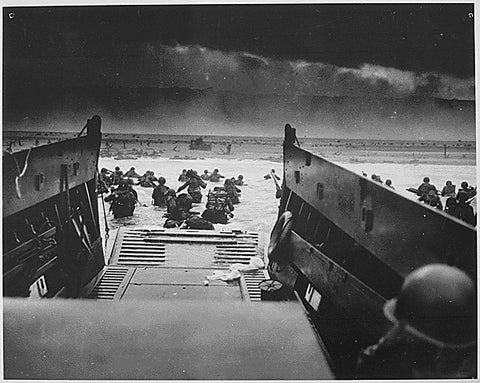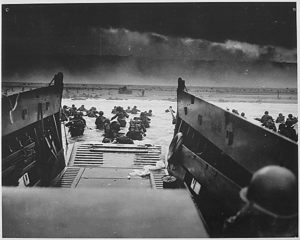
D-Day Plus $: Does the Commercialization of Normandy Disrespect the Legacy of the Landings?

“Fat-biking on Omaha Beach?” a fellow tourist muttered next to me this past April as we stood facing the English Channel that once ran red with Allied blood. “What’s next, dirt biking at Auschwitz?”
He wasn’t far off.
With a generation entranced by TikTok, Instagram and other such timesucks, memorials, battle sites and re-enactors have been searching for ways to engage younger generations to not only impart knowledge but to stay relevant and running.
Their solution, it seems, is to border on trivializing the hardships that these soldiers, sailors, and airmen endure and underestimate the intelligence of those who choose to visit these hallowed grounds — cue D-Day: A Millennials Guide — in one fell swoop.
It also begs the question: When does commemoration cross over to commercialization? When does a place of reverence no longer remain protected?
SELLING OMAHA BEACH
“Take a slow look at the horizon surrounding the crescent-shaped beach called “Omaha Red” in Normandy. It is an interesting panorama. In all that vast perimeter you will see no point where the sea meets the sky. Ships of all sizes — battlewagons, destroyers, carriers, LSTs, other landing craft, launches, army “ducks” — solidly fill the water. The sight is impressive, glorious, but loses some majesty to the memory of the day before, when you climbed into one of the box-like landing craft among the bodies of those who had gone before and crouched the eight uneventful miles to the French shore.” — D-Day veteran Gordan Hearne, 1948.
Now imagine taking in that sight in for the cool, cool price of 15 euros as you tear up and down the Omaha Red beachhead on your fat-bike.
“You sit numbly and marvel at the extraordinary redness of lifeblood, and, as the constriction starts in your gut, you know fear. As the craft’s ramp lowers you somehow get reaction from motor nerves, you move ahead, acting apart from yourself, scarcely hearing the officer’s periodic “Go … go … go ….” You push yourself out into waist-deep water, wondering if you should take the waterproofing off your M1, wishing there were cover, for the first time feeling the nakedness of the battlefield, where you are so alone, so much the prey of human fear and terror, that the shore seems to move ahead.” — Hearne, 1948.
For just 20 euros you can have an hour–long BMX “Pumptrack”-supervised session as you overlook the coast where 2,400 Americans were killed or wounded.
For some, the thought of tourist cyclists high-fiving each other on the very sands where their grandfathers bled out from German bullet wounds is akin to another assault — this one on propriety itself.
FIGHTING FOR NORMANDY AGAIN
The commercialization of the Normandy coastline has not gone unnoticed by residents and surviving veterans themselves — with many putting up a fight.
Projects are underway like Homage to Heroes, which is set to have an 800-seat theater for an “immersive” experience that will amalgamate live actors and archival footage to tell the story of the Normandy invasion.
“We asked ourselves, ‘How can we make some sort of legacy for our kids first to remember what happened in Normandy during World War II?’ Today you can find movies, TV shows and books about the war, but there is no show telling the story of these men,” Roberto Ciurleo, one of three co-producers on the project, told NBC News.
DISNEYFIED D-DAY
Critics of the project liken it to something akin to D-Day Disney, however.
“The war is not a show. It’s history, and you must respect people who gave their life for freedom,” said 100-year-old veteran Leon Gautier, a former French marine with the Kieffer commandos who fought with the British on D-Day.
“They want money for history, and we don’t agree to that,” he told NBC News.
The National 4th Infantry Division Association agreed, sending a letter of opposition to the project in October 2020, saying it is “appalling” that “anyone would consider turning the sacred grounds of Normandy into a profit focused amusement park.”
Despite this, Homage to Heroes is set to open in 2024 — the 80th anniversary of Operation Overlord — to the tune of 58 million.
HOLOCAUST HOMAGE OR HORROR?
The commercialization quandary that plagues the shores of Normandy seem to be universal.
A memorial museum at Babyn Yar, a forested ravine on the outskirts of Kyiv where 33,771 Jewish civilians were massacred in the span of two days, has drawn controversy over another proposed “immersive” plan that some critics contend would only be disturbing to visitors.
Unveiling his plan in the fall of 2019, controversial Russian filmmaker Ilya Khrzhanovsky stated that each visitor would fill out a questionnaire and take a psychological test upon entering the museum. A computer algorithm would then assign each person the role of executioner, collaborator or victim, and the museum experience would be tailored accordingly, Khrzhanovsky said.
Visitors might wear virtual reality goggles as they are led down blacked-out corridors, while “so-called deep fake technology might show video re-enactments of the horror with the visitors’ own faces pasted onto characters in the scenes. The presentation notes the technology is used to create ‘fake celebrity pornographic videos’ but might be repurposed for Holocaust remembrance,” according to the New York Times.
The presentation notes that the museum’s aim is to create a “challenging and sometimes shocking emotional journey with ethical choices at its core.”
In April 2020, Dieter Bogner, an Austrian art historian and leading museum design specialist, wrote a heated resignation letter, saying the “core exhibit dangerously approaches the impression of a Holocaust Disney.”
Since the Russian invasion of Ukraine, plans for the museum have been put on hold.
WHEN MEMORY BECOMES MUTILATION
For some, the line between remembrance and entertainment has increasingly become perilously thin. Will shock value or good old-fashioned fun on a fat-bike replace the “staid” experience of somber reflection?
While new strategies of historical engagement in a digital age are certainly welcome, the impulse for bigger and better in conjunction with the Second World War should perhaps be tempered — if not outright condemned.
